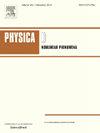Evaluation of probability density function descriptions for three-component Rayleigh–Taylor mixing
IF 2.7
3区 数学
Q1 MATHEMATICS, APPLIED
引用次数: 0
Abstract
Results from simulations of a three-component Rayleigh–Taylor (RT) mixing problem are presented. These simulations are conducted in heavy–light–heavy and heavy–intermediate–light configurations, and each of these configurations are further considered in high- and low-Reynolds-number regimes. This results in RT-unstable flow with one or both interfaces initially unstable, permitting the influence of problem configuration on the statistical description of three-component RT-driven mixing to be considered. Mass fraction covariances are observed to undergo a sign change through the mixing layer in all four configurations considered. This appears to be unique to the multi-component case and represents another way in which multi-component RT mixing differs from the two-component case. Qualitative and quantitative comparisons of joint and marginal probability density function (PDF) descriptions of species concentration are made. Three-, five-, and six-parameter model PDFs are compared against simulation data to assess how accurately they describe the mixing, and it is found that three-component mixing requires at least a five-parameter model PDF to accurately describe the mixing. Notably, the marginal distributions of three-component mixing do not appear to conform to a beta distribution, representing a departure from the classical two-component RT case. Statistical neutrality also appears to influence the optimal choice of model PDF, which is found to be a function of problem configuration.

三分量瑞利-泰勒混合的概率密度函数描述评价
给出了三分量Rayleigh-Taylor (RT)混合问题的模拟结果。这些模拟是在重-轻-重和重-中-轻两种构型下进行的,每种构型都进一步考虑了高和低雷诺数的情况。这导致一个或两个界面初始不稳定的rt不稳定流,允许考虑问题配置对三组分rt驱动混合的统计描述的影响。在所考虑的所有四种配置中,观察到质量分数协方差在混合层中经历符号变化。这似乎是多组分情况所特有的,并且代表了多组分RT混合不同于双组分情况的另一种方式。对联合概率密度函数和边际概率密度函数描述的物种浓度进行了定性和定量比较。将三参数、五参数和六参数模型PDF与模拟数据进行比较,以评估它们描述混合的准确性,发现三组分混合至少需要一个五参数模型PDF才能准确描述混合。值得注意的是,三组分混合的边际分布似乎不符合beta分布,这与经典的双组分RT情况有所不同。统计中立性似乎也影响模型PDF的最优选择,这被发现是问题配置的函数。
本文章由计算机程序翻译,如有差异,请以英文原文为准。
求助全文
约1分钟内获得全文
求助全文
来源期刊

Physica D: Nonlinear Phenomena
物理-物理:数学物理
CiteScore
7.30
自引率
7.50%
发文量
213
审稿时长
65 days
期刊介绍:
Physica D (Nonlinear Phenomena) publishes research and review articles reporting on experimental and theoretical works, techniques and ideas that advance the understanding of nonlinear phenomena. Topics encompass wave motion in physical, chemical and biological systems; physical or biological phenomena governed by nonlinear field equations, including hydrodynamics and turbulence; pattern formation and cooperative phenomena; instability, bifurcations, chaos, and space-time disorder; integrable/Hamiltonian systems; asymptotic analysis and, more generally, mathematical methods for nonlinear systems.
 求助内容:
求助内容: 应助结果提醒方式:
应助结果提醒方式:


